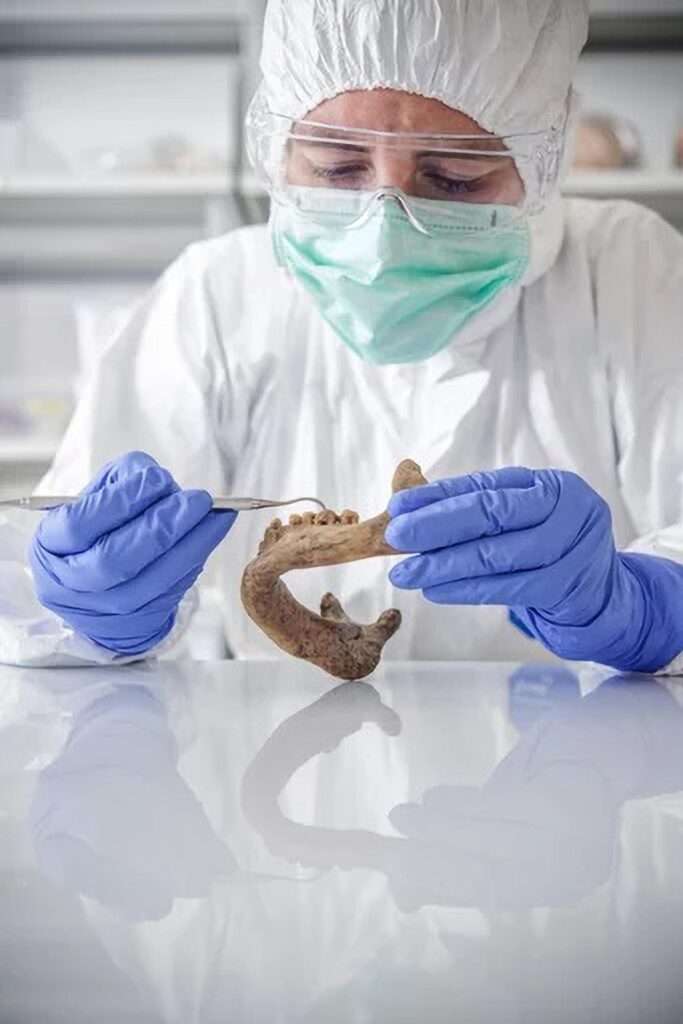Scientists have revived Stone Age microbes from 100,000-year-old Neanderthal teeth that they say could be a breakthrough in the hunt for new antibiotics.
The microbes have been isolated from plaque found on the teeth by an international team of scientists trying to discover how ancient DNA worked.
Now, they say, they have managed to revive previously unknown bacteria and microbes that could boost the development of new medicines.
The study was carried out by Harvard University, Germany’s Max Planck Institute for Evolutionary Anthropology and the Leibniz Institute for Natural Product Research and Infection Biology.
Scientists have already hailed the results as the answer to “a billion-piece jigsaw puzzle”.
The study included 12 Neanderthals who roamed Earth 40,000 to 102,000 years ago, 34 human skeletons dating to around 150 to 30,000 years ago, and 18 present-day humans.

Scientists revived the ancient bacteria by building a biotechnology platform using their genetic blueprints.
In a statement obtained by Newsflash, the Max Planck Institute said on 4th May: “Microbes are nature’s greatest chemists and among their creations are a large number of the world’s antibiotics and other therapeutic drugs.
“Producing these complicated chemical natural products is not straightforward, and to do so bacteria rely on specialised kinds of genes that encode enzymatic machinery capable of making such chemicals.
“At present, scientific study of microbial natural products is largely limited to living bacteria, but given that bacteria have inhabited the earth for more than three billion years, there is an enormous diversity of past natural products with therapeutic potential that remain unknown to us – until now.”
Christina Warinner – Assistant Professor of Anthropology at Harvard University and the survey’s co-senior author – said: “In this study, we have reached a major milestone in revealing the vast genetic and chemical diversity of our microbial past.”
Prof Dr Pierre Stallforth – who heads the Department of Paleobiotechnology at the Leibniz Institute – added: “Our aim is to chart a path for the discovery of ancient natural products and to inform their potential future applications.
In its statement, the Max Planck Institute explained: “When an organism dies, its DNA rapidly degrades and fragments into a multitude of tiny pieces. Scientists can identify some of these DNA fragments by matching them to databases.
“But for years, microbial archaeologists have struggled with the fact that most ancient DNA cannot be matched to anything known today.”
It added: “This problem has long vexed scientists, but recent advances in computing are now making it possible to refit the DNA fragments together – much like the pieces of a jigsaw puzzle – in order to reconstruct unknown genes and genomes.

“The only problem is that it does not work very well on highly degraded and extremely short ancient DNA from the Pleistocene.”
Alexander Huebner – a postdoctoral researcher at the Max Planck Institute for Evolutionary Anthropology – admitted: “We had to completely rethink our approach.”
Huebner explained that, after three years of testing and optimisation, the team achieved reconstructing stretches of DNA of more than 100,000 base pairs in length and the recovery of a wide range of ancient genes and genomes.
The researcher revealed: “We can now start with billions of unknown ancient DNA fragments and systematically order them into long-lost bacterial genomes of the Ice Age.”
According to the MPG, the scientists focused on reconstructing bacterial genomes encased within dental calculus – also known as tooth tartar – from 12 Neanderthals dating to 102,000 to 40,000 years ago, 34 archaeological humans dating to 30,000 to 150 years ago and 18 present-day humans.
Neanderthals are the closest evolutionary relatives of humans living today. The oldest known Neanderthals are about 400,000 years old. They became extinct around 40,000 years ago.
Compared to present-day humans, the Neanderthals had more pronounced eyebrow bulges and a fleeing forehead. Neanderthals also had a chinless face with peculiar nasal cavities, which made it easier to warm up cold air when inhaling.
The cause of their extinction remains highly contested. Demographic factors like small population size, inbreeding, and random fluctuations are considered likely factors.
The scientific institute said: “Tooth tartar is the only part of the body that routinely fossilises during the lifetime, turning living dental plaque into a graveyard of mineralized bacteria.
“The researchers reconstructed numerous oral bacterial species as well as other more exotic species whose genomes had not been described before.
“Among these was an unknown member of Chlorobium whose highly damaged DNA showed the hallmarks of advanced age and which was found in the dental calculus of seven Paleolithic humans and Neanderthals.
“All seven Chlorobium genomes were found to contain a biosynthetic gene cluster of unknown function.”

Leibniz Institue postdoctoral researcher Anan Ibrahim explained: “The dental calculus of the 19,000-year-old Red Lady of El Miron, Spain, yielded a particularly well-preserved Chlorobium genome. Having discovered these enigmatic ancient genes, we wanted to take them to the lab to find out what they make.”
The experts used the tools of synthetic molecular biotechnology to allow living bacteria to produce the chemicals encoded by ancient genes.
According to the MPG, this was the first time this approach has been successfully applied to ancient bacteria.
It said: “It resulted in the discovery of a new family of microbial natural products that the researchers named ‘paleofurans.'”
Leibniz Institute postdoctoral researcher Martin Klapper said: “This is the first step towards accessing the hidden chemical diversity of earth’s past microbes.”
He pointed out that the findings would “add an exciting new time dimension to natural product discovery.”
To find out more about the author, editor or agency that supplied this story – please click below.
Story By: Thomas Hochwarter, Sub-Editor: Marija Stojkoska, Agency: Newsflash
The Ananova page is created by and dedicated to professional, independent freelance journalists. It is a place for us to showcase our work. When our news is sold to our media partners, we will include the link here.




